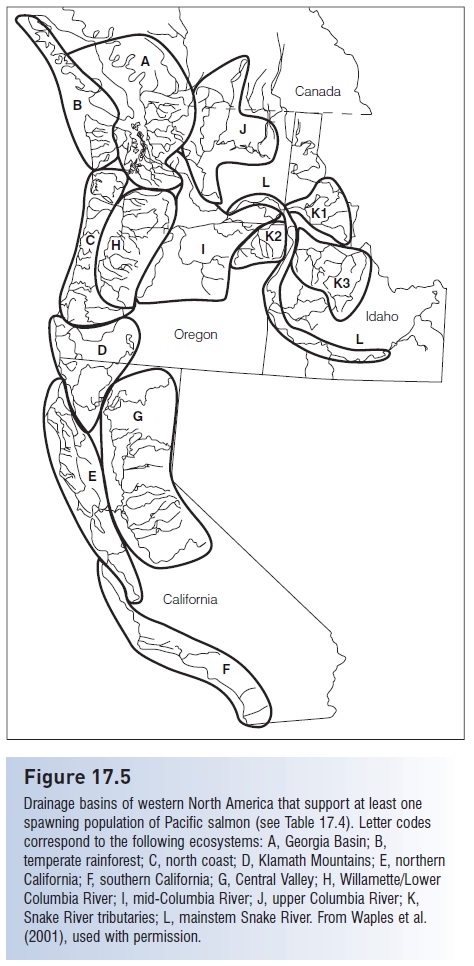Chapter: The Diversity of Fishes: Biology, Evolution, and Ecology: Fish genetics
Anadromous fishes - Fish genetics: Phylogeography
Anadromous fishes
These typically show strong site fi delity when they return from the ocean to natal streams to spawn, but with an error rate that is high enough to allow colonization of adjacent rivers. Anadromous salmon are the subject of much scientific interest because their life history (especially the site fi delity of spawning adults) is a compelling focus for ecological and genetic studies, and because of the wildlife management and conservation issues associated with salmon fisheries. Life history and population genetic studies provide a scientific foundation for resolving stocks, populations (in the genetic sense), and ESUs (see above, Population genetics). The seven species of anadromous salmon and trout (genus Oncorhynchus) on the Pacific coast of North America are the most widely studied in the world, with extensive allozyme, mtDNA, and microsatellite inventories. Here there is a management mandate to define “distinct population segments” under the US Endangered Species Act, using ecology, life history, and genetics (Waples et al. 2001). Note that since genetics is not the sole criterion, differences in behavior (especially the timing of migrations to and from the ocean) are incorporated as well.
Currently the salmon and trout in US waters are divided into 12 ecologically distinct regions (Fig. 17.5), most corresponding to major tributaries and drainages. Within these 12 regions are a total of 58 designated ESUs (Table 17.4). Chinook Salmon (O. tshawytscha) and Steelhead Trout (O. mykiss) have the widest range and the most subdivisions, with 17 and 15 ESUs, respectively. Chinook, Steelhead, Sockeye (O. nerka) and Coastal Cutthrout (O. clarki clarki) also have considerable diversity in life history, particularly in the timing of smolting and spawning migrations, and all but Chinook have nonanadromous, “landlocked” populations. Some anadromous Sockeye populations use lakes for juvenile development, whereas others use a riverine habitat or migrate quickly to the sea. In contrast, Chum (O. keta), Pink (O. gorbuscha), and Coho Salmon (O. kisutch) are relatively infl exible in life history traits, including a very brief freshwater stage in the first two species (Groot & Margolis 1991; Quinn 2005).
Three species have anadromous and non-anadromous (remaining in fresh water) forms that inhabit the same drainages: Sockeye/Kokanee, Steelhead/Rainbow Trout, sea-run/freshwater Cutthroat Trout. The genetic surveys demonstrate that in each case, the two forms within each drainage are closely related populations, relative to populations with the same behavior in other drainages (Foote et al. 1989; Utter et al. 1989). These life history variants, including the option of remaining in fresh water, arose independently in each drainage.

Figure 17.5
Drainage basins of western North America that support at least one spawning population of Pacific salmon (see Table 17.4). Letter codes correspond to the following ecosystems: A, Georgia Basin; B, temperate rainforest; C, north coast; D, Klamath Mountains; E, northern California; F, southern California; G, Central Valley; H, Willamette/Lower Columbia River; I, mid-Columbia River; J, upper Columbia River; K, Snake River tributaries; L, mainstem Snake River. From Waples et al. (2001), used with permission
The exception to this pattern are the Chinook Salmon in the Columbia and Snake Rivers, where deep genetic partition exists between stream-maturing and oceanmaturing forms (Myers et al. 1998). Spring-spawning salmon of the stream-maturing type co-occur with fallspawning salmon of the ocean type, but they do not interbreed, another example of complex population structure (see above, Population structure). Pink Salmon are hard wired to a 2-year breeding cycle, so that even-year spawners never encounter odd-year spawners. The result is two distinct ESUs in a single species that inhabit the same feeding areas, mate in the same location at the same time of year, but never interbreed (Churikov & Gharrett 2002).
Sockeye and Cutthroat have strong population structure, and in both cases this structure is linked to higher dependence on freshwater habitat. The Sockeye is anadromous but requires lake habitat for juvenile development, whereas the Cutthroat is non-anadromous throughout much of its inland range. In the populations that have access to the ocean, many individuals stay in fresh water, and sea-running individuals do not migrate far from their river of origin (Johnson et al. 1999). Hence Cutthroat may be described as the least anadromous member of the genus Oncorhynchus in western North America. Recall the pattern in Table 17.2 wherein freshwater fishes have more population structure than anadromous fishes, which have more structure than marine fishes. In this hierarchy, it makes sense that the least anadromous fish would have the highest genetic structure (Waples et al. 2001).
Finally, the conservation genetics of these Pacific salmon are a matter of much concern. Perhaps 30% of the ESUs (corresponding to 27% of the genetic diversity) that existed prior to European contact are extinct, and another third are listed as endangered or threatened (Gustafson et al. 2007). Much has been lost, but enough remains to rebuild these stocks under prudent management regimes. However, widespread aquaculture of salmon has the potential to corrupt native populations. Interbreeding with fish that escape from captivity has the potential to introduce maladaptive genetic traits into local populations (Utter 2004).
Related Topics